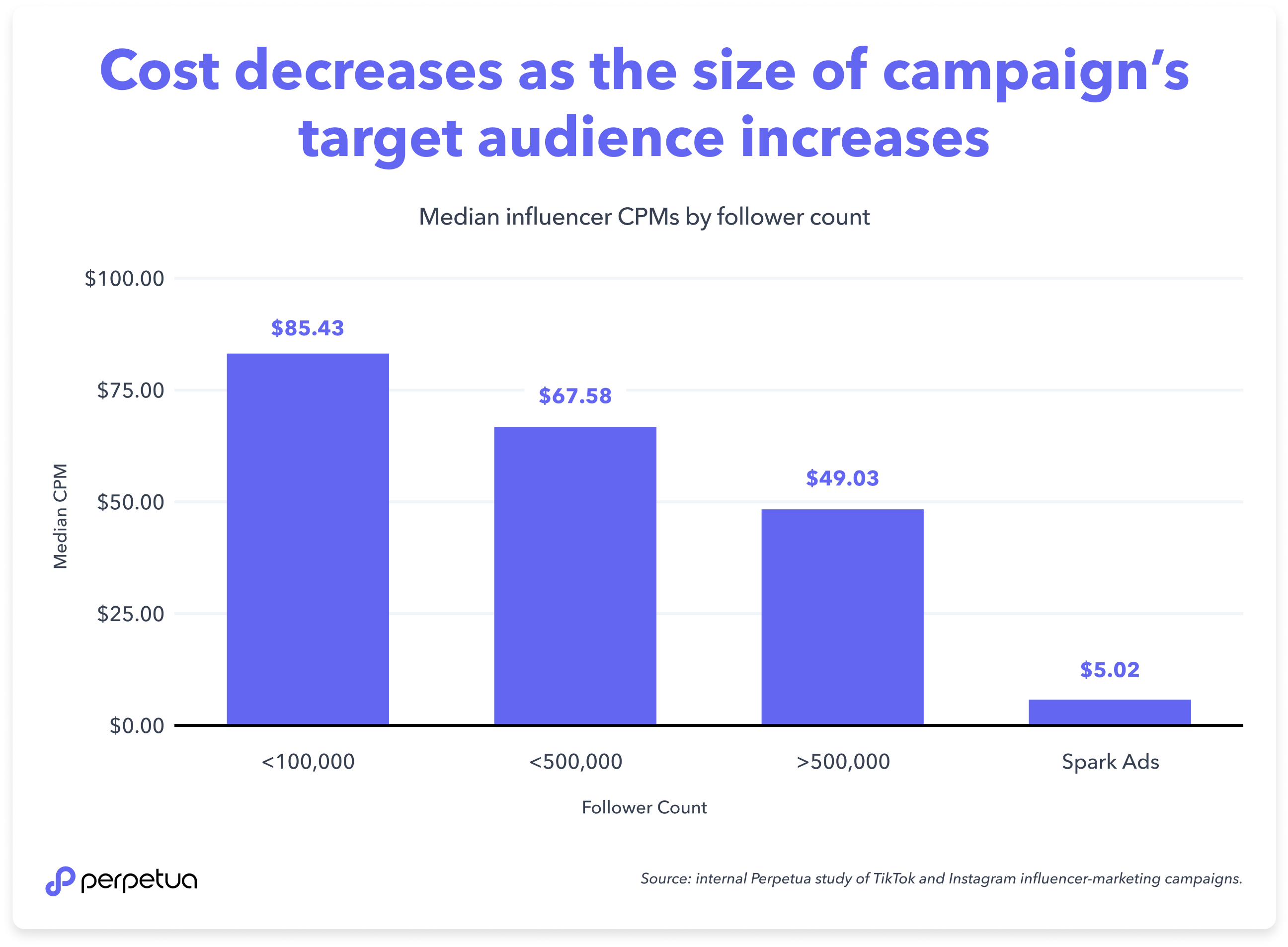
Understanding creator-influenced paths to purchase and influencer-marketing metrics you should care about
Lauren Biricz, April 6, 2023
Influencer marketing has quickly become one of the hottest trends in digital advertising, and for good reason. Partnering with the right influencers for your brand can create long and lasting success in terms of organic traffic, brand reputation, and overall ROI. On top of generating new creative assets, collaborations with creators will also allow advertisers to increase brand reach and engagement with niche audiences.
That said, measuring the performance and full-funnel impact of an influencer campaign is a notorious challenge for advertisers. But why? Let’s unpack this topic below.
Problem: viewers tend to search rather than navigate to the account’s bio
In a perfect world, interested users will see an advertisement, engage with the content, follow the creators’ instructions to the link in their bio to view the product, and purchase in the same pop-up browser from Instagram or TikTok.
Sadly, users can get lost at any point in this journey, resulting in no sale or a sale that isn’t attributed to the influencer’s campaign. In fact, it is common for users to view an influencer campaign and complete a purchase for the promoted product without ever clicking on an attribution link.
Instead, users may choose to save the video and buy the product later, or not interact with the video and keep the brand or product name in mind for their next Amazon haul. Consumers could also choose to put the item on their wishlist for someone else to buy organically; they could purchase the product from their own Amazon app or web browser immediately after being influenced; or they could even tell their friends about it and order together in the future to save on shipping.
That said, none of the paths to purchase mentioned above are likely to register as attributed sales for your influencer campaign. And there are many more purchase journeys than the ones listed above that users can take. So why is this activity so hard to track? And how long will it take to see an impact on the brand side? It depends.
Problem: obstacles to tracking created by TikTok and Instagram’s use of proprietary browsers
Often influencer campaigns do not receive any attributed sales due to friction in the buying process and limitations in cross-app tracking that now affects all iOS and Android devices. This can be a very daunting problem, given the investment necessary to get an influencer campaign off the ground.
The first roadblock is the use of proprietary browser systems within TikTok and Instagram. This type of browser blocks the flow of data to and from the webpage, meaning if you click on an Amazon.com link from Instagram or TikTok, you will be directed to Amazon within a browser where you are not logged into your Amazon account (if you have one).
As such, few interested users—if any—will choose to log in to their account after viewing a product to complete the purchasing process. Wouldn’t it be easier to add the item to your next Amazon haul? Or simply go to the Amazon app where you don’t have to worry about entering the password you're always struggling to remember? Probably. Simply put, this lack of convenience is a key reason why people choose to complete their purchases outside of attribution links.
Adding to this friction is the disabled flow of data from third-party apps on your device. In 2021, iOS and Android gave users the option to disable all cross-app and cross-site tracking for apps, previously used for advertising purposes. If this disable-all option is not selected, apps that use such tracking mechanisms will show a popup asking you to enable tracking features. To the woe of advertisers, this opt-out rate averages 94% among Apple users in the USA, according to a study by Flurry, an app analytics company.
This means when a user views your campaign and even clicks on the attribution link—if they leave their social app to purchase the product on a new app without making the minor adjustment in their user window to “open in Amazon”—that user journey cannot be tracked for the vast majority of users.
Solution: incentivizing users down measurable paths
However, there is a way to incentivize users down a purchasing journey that can be easily measured – and this is through discount codes. By using coupons or discount codes for each influencer, brands will be able to attribute the amount of revenue generated from each post and creator while providing the audience with an incentive to purchase in a way that can be tracked.
Obviously, any discount will mean less money in the brands’ pocket, but providing a modest discount may be worth it if you’re looking to generate the most data possible on the traffic created from your influencer campaign. Not to mention, roughly 60% of consumers are likely to try a new product as a result of a discount code, according to a survey by Vericast.
Relevant metrics and why they're important
Owing to differences in consumer purchasing behavior and the myriad paths that shoppers can take before purchasing a product, it's increasingly important to monitor metrics such as reach, impressions, organic sales, branded searches, search term rank, and search term share-of-voice.
Firstly, an increase in branded searches is an extremely positive sign as more consumers searching for your brand name indicates that brand awareness has measurably increased. An increase in branded searches following the beginning of a creator marketing campaign can indicate that a large number of people saw the content, were interested, and wanted to learn more about your product. Instead of clicking a link to your product, they searched for your brand on their own and may have made a purchase.
Let’s take a look at impressions next. Impressions provide a clear representation of how many times your ad was viewed on a particular social channel. Reviewing the number of impressions a campaign generates is one of the simplest ways to evaluate the visibility of your campaign. Comparing this value to total PDP (product detail page) sessions, or DPVs (detail page views), in the months following the campaign will also be an indication of whether or not your ad reached the right audience, with high purchase intent.
Cost per mille (CPM) helps brands further evaluate the efficacy of their ad campaigns to reach mass audiences. CPM is the cost of 1000 impressions of your content; this figure essentially evaluates campaign visibility, and what you pay for it, shedding light on what it takes to widen the top of the purchase funnel. From a brand-building perspective, if we target a wider audience to engage potential new-to-brand customers, CPM usually tends to be cheaper.

Other metrics to keep a keen eye on are organic rank and search term share-of-voice. These metrics help brands measure the marketplace impact of their ad campaigns. They answer questions like, How well did your ad reach users with high purchase intent? A product increases in organic rank for a specific keyword the more it is clicked on and purchased by consumers using search terms that correspond to the keyword(s). An increase in organic rankings for your product within 1-3 days of your creator marketing campaign going live, although not directly attributable, is an indication that more people are searching for and purchasing your product.
Keyword rankings also determine how much click traffic your product receives, as higher-ranking PDPs receive more organic search traffic. If you can successfully influence your consumers to click on your product over your competitors and complete a purchase after a creator recommendation, you are fueling the self-perpetuating flywheel for long-term Amazon success. An increase in traffic leads to an increase in sales, which leads to better rankings, more traffic, and more sales.
Last but not least, organic sales is one of the most important metrics to track when evaluating campaign performance. All users that come onto Amazon and search for a brand or product after viewing an advertisement will be measured as organic branded searches and ideally organic sales. As mentioned above, consumers may see an ad and proceed to follow a variety of different actions whether it be saving/liking the post, simply remembering the brand name, or viewing the influencer content, leaving the social channel, and going to their Amazon app to purchase. Despite this sale originating from a creator’s influence, it will not count as an attributed campaign sale, it will register as organic.
Therefore, brands should expect to see a rise in organic sales following an influencer campaign. If you are running retail media ads as well, users may click on your Sponsored Products or Sponsored Brands ad because they have seen raving influencer reviews on social media channels. In this case, it is just as important to monitor the traffic on your sponsored ads as your organic rankings and organic sales.
The bottom line
When you run influencer marketing campaigns, you are choosing to play the long game by investing in brand building and creating brand awareness for lasting growth. Influencer marketing is an upper-funnel strategy used to attract qualified shoppers to your products and brand name, and sometimes it can take months for an influencer campaign to have its desired effect.
Don't let that discourage you. Even huge names like Airbnb cited brand marketing as its most important avenue for growth. The short-term rental giant continued to invest the bulk of its marketing spend in brand-building in 2022 after having their most profitable year to date in 2021. Still, to move consumers down the purchase funnel to consideration, evaluation, and eventually purchase, they need to be constantly reminded of your products and brand. This can be achieved through continuous collaborations with creators, ad targeting, retargeting, and targeting again. Through Perpetua’s Influencer Network, your brand has the ability to launch campaign goals within minutes, connect with influencers, and retarget advertisements to niche audiences all within one platform.
The road to influencer success may seem winding, but all in all, the full-funnel impact of any influencer marketing is best measured by keeping a keen eye on your KPIs, using a coupon code if you can, and having faith in the process.
Want to learn more about influencer marketing? Check out our complete guide for all the information you need.
To get started or learn more about how Perpetua can help you scale your Amazon Advertising business, contact us at hello@perpetua.io